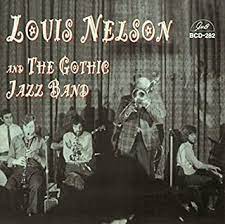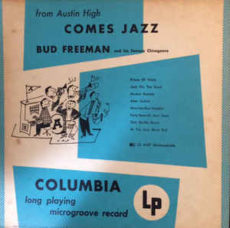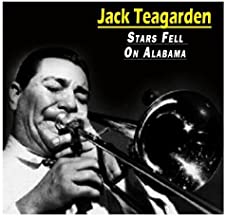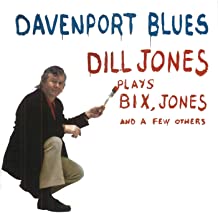
Daily Dose Of Jazz…
Louis Nelson was born September 17, 1902 in New Orleans, Louisiana. Both parents and his sister played the piano, his brother played the saxophone. In December 1902, his parents moved to Napoleonville, Louisiana because his father couldn’t get medical patients after the July 1900 Robert Charles Race Riots in New Orleans.
At the age of fifteen he started playing the valve trombone and switched to the slide trombone, studying under Professor Claiborne Williams. Graduating high school in 1919, Louis’ first band was Joe Gabriel’s band playing in dance halls for a dollar a night.
While in New Orleans in the 1920s, Nelson played jazz with Buddy Petit, Kid Rena, Kid Punch Miller, Sam Morgan, Chris Kelly, Papa Celestin, Willie Pajeaud, Kid Howard, Sidney Cates, and Kid Harris’ Dixieland Band. He would go on to join the Sidney Desvigne Orchestra. During the Depression, he joined the Works Progress Administration and became first chair in the WPA band, then volunteered for the U.S. Navy during WWII. Post Navy he played with Sidney Desvigne’s Orchestra, Kid Thomas Valentine, and Herbert Leary Orchestra. To make ends meet he took numerous day jobs from the post office to a janitor. In 1949, made his first recording with clarinetist and leader Big Eye Louis Nelson Delisle. This recording, by jazz historian Bill Russell of AM Records, marked the beginning of an extensive recording career for him.
Preservation Hall gave Louis permanent work, exposure to a new audience, and provided numerous opportunities for travel abroad as both a soloist and band member of the Billie and De De Piece and Kid Thomas Valentine’s bands.
He toured extensively from 1963, beginning with the George Lewis Band in Japan, Eastern and Western Europe, South America, Australia, Canada, and Mexico, as well as throughout the United States. Nelson appeared at every New Orleans Jazz and Heritage Festival, joined the Legends of Jazz and was featured in many New Orleans jazz documentaries.
Trombonist Louis Nelson, who in 1981 received a NEA grant and developed a program in which he played for New Orleans public school students and discussed New Orleans jazz history, passed away on April 5, 1990 of injuries suffered from a March 27 hit-and-run automobile accident. The driver was never caught.
More Posts: bandleader,history,instrumentl,jazz,music,trombone

Daily Dose Of Jazz…
David Walter Bowman was born September 8, 1914 in Buffalo, New York but was raised in Hamilton, Ontario, Canada, where he learned to play piano as a four year old.
He moved to Pittsburgh, Pennsylvania and played there for a time, then went to London, England working with Jack Hylton in the mid-1930s. After returning to the States he settled in New York and played with Bobby Hackett, Sharkey Bonano, Sidney Bechet, and Bud Freeman late in the decade.
In the early 1940s, he worked with Jack Teagarden, Joe Marsala, Muggsy Spanier, Lee Wiley, and Eddie Condon. He took positions with ABC and NBC in the late 1940s including Perry Como and worked as a studio musician on recordings.
In the 1950s, he once again worked with Bud Freeman and with Phil Napoleon shortly before his own death. Pianist Dave Bowman passed away from an automobile accident on December 28, 1964 in Miami, Florida.
More Posts: history,instrumental,jazz,music,piano

Daily Dose Of Jazz…
Horst Konrad “Conny” Jackel was born on August 30, 1931 in Offenbach am Main, Germany. Initially working as a steel construction fitter, he attended the conservatory in 1951 and from 1952 played in the clubs of the US Army in France, the Netherlands and Germany.
In 1955 he became a member of the Helmut Brandt Combo, contributing to its success. In 1959 he went on to perform the equally demanding arrangements of the Media Band of Harald Banter in Cologne. 1961 saw Jackel moving to the Erwin Lehn Orchestra in Stuttgart, where he performed with Miles Davis, Chet Baker, Dizzy Gillespie and Frank Sinatra.
From 1964 to 1969 he was a member of the Hessischer Rundfunk Jazz Ensemble led by Albert Mangelsdorff, then became first trumpet of the orchestra in 1967 under Willy Berking and the HR Big Band under Heinz Schönberger. He would go on to perform with Joki Freund, Rudi Sehring, Attila Zoller, Charly Antolini and the Sugar Foot Stompers among other traditional bands.
Suffering from cancer, he lost his lower jaw to amputation forcing him to give up the trumpet. Occasionally he was active as a drummer with The Bookreaders. After a long illness as a result of an operation, trumpeter and flugelhornist Conny Jackel, whose motto was “No beer – no music!”, passed away on April 28, 2008 in Bad Nauheim, Germany.

Daily Dose Of Jazz…
Jack Teagarden was born Weldon Leo Teagarden on August 20, 1905 in Vernon, Texas into a musical family, two brothers, a sister and father all musicians. His father started him on baritone horn but by age seven he had switched to trombone. His first public performances were in movie theaters, where he accompanied his mother, a pianist.
By 1920, Teagarden was playing professionally in San Antonio, Texas with the band of pianist Peck Kelley. In the mid-1920s he started traveling widely around the United States in a quick succession of different bands. 1927 saw him in New York City where he worked with several bands and by 1928 he was playing with the Ben Pollack band.
In the late 1920s, he recorded with such bandleaders and sidemen as Louis Armstrong, Benny Goodman, Bix Beiderbecke, Red Nichols, Jimmy McPartland, Mezz Mezzrow, Glenn Miller, and Eddie Condon. Miller and Teagarden collaborated to provide lyrics and a verse to Spencer Williams’ “Basin Street Blues”, which in that amended form became one of the numbers that Teagarden played until the end of his days.
Seeking financial security during the Great Depression, Jack signed an exclusive contract to play for the Paul Whiteman Orchestra from 1933 through 1938. In 1946, he joined his lifelong friend Louis Armstrong and his All Stars. In late 1951, he left to again lead his own band.
Suffering from pneumonia, trombonist and singer Jack Teagarden, considered the most innovative jazz trombone stylist of the pre-bebop era, passed away in New Orleans at the age of 58 on January 15, 1964.
More Posts: bandleader,history,instrumental,jazz,music,trombone,vocal

Daily Dose Of Jazz…
Dill Jones was born Dillwyn Owen Paton Jones on August 19, 1923 in Newcastle Emlyn, Carmarthenshire, Wales. He was brought up in New Quay on the Cardiganshire coast. Music was in the family, his mother a pianist and his aunt played organ at the Methodist Tabernacle. He was exposed to jazz as a 10-year-old by hearing records by Fats Waller and Bix Beiderbecke on the radio.
After leaving college, Jones followed his father into banking but was called up by the Royal Navy for wartime service in the Far East. When the war ended he enrolled at Trinity College of Music in London, England but did not complete the course, preferring the informality of late night jazz sessions.
Joining the Harry Parry Sextet and Vic Lewis’ Orchestra before plying his trade as ship’s pianist on the luxury liner, the Queen Mary, he sailed between New York City and Southampton. This gave Dill the chance to hang out in New York’s jazz clubs and hear Coleman Hawkins and Lennie Tristano, among others. After forming the Dill Jones Quartet in 1959, he emigrated to the United States in 1961, settling in New York City. He became an expert in the Harlem stride style. was soon in demand, earning his reputation playing with the likes of Gene Krupa, Jimmy McPartland and Yank Lawson.
Between 1969–1973, Jones was a member of the JPJ Quartet with Budd Johnson, Oliver Jackson and Bill Pemberton. A double CD anthology of Dill Jones` work was released in 2004, entitled Davenport Blues – Dill Jones plays Bix, Jones and a Few Others.
Pianist Dill Jones, who was instrumental in bringing jazz to British television when he hosted the BBC Jazz Club, passed away from throat cancer in a New York hospital on June 22, 1984. He was 60



